

The Istana Satu (First Palace) was a royal residence in Kuala Terengganu in Malaysia.


The Istana Satu (First Palace) was a royal residence in Kuala Terengganu in Malaysia.
The Istana Satu was erected by Sultan Zainal Abidin III, Sultan of Terengganu in 1884 in the compound of Kota Istana Maziah, Kuala Terengganu. This building is of Terengganu Malay traditional architecture, in the form called "Rumah Tiang Dua Belas". The wood used is cengal. Istana Satu was erected in the Muzium Negara compound in April 1974.
The restored palace is a wooden house designed for the tropics. Standing on stilts that allow air to circulate freely under the building, the palace’s steep thatch roof helps keep the interior of the house cool. Intricate wood carvings adorn the doors and windows.
The guest hall of the istana is furnished with a cupboard that is made of carved wood with gold inlaid and complete with a mirror. The cupboard is used to store small decorative items. A hanging lamp is positioned from the ceiling, and a brass foot tray with legs is placed in the hall of visitors. Spread out is a mat made out of mengkuang leaves, a Malay feature to honour guests, and brass shields are mounted on the left and right walls. The kitchen of the istana is made from wood carved with floral motifs. Arranged on the table are a food cover made of woven mengkuang leaves and brass tray symbolising the pride and identity of the Malay race, together with a glass lamp. Kitchen utensils are stored in the cupboard.
Standing next to the Istana Satu are two keliriengs or burial poles. A kelirieng is made of a huge hardwood tree trunk, carved from the top to bottom. Niched up to its sides is a space for the bodies of slaves and followers and hollowed at the top to place the jar containing the chief’s bones.
The istana is located today on the grounds of the National Museum of Malaysia.
![]() Media related to Istana Satu at Wikimedia Commons
Media related to Istana Satu at Wikimedia Commons

Kuala Terengganu, colloquially referred to as KT, is the administrative, economic and royal capital of the state of Terengganu, Malaysia. Kuala Terengganu is also the capital of Kuala Terengganu District. It is also the only royal capital among the nine royal states of the country to bear its state's name. Kuala Terengganu is located about 440 kilometres northeast of Kuala Lumpur on the East Coast of Peninsular Malaysia. The city is situated at the estuary of Terengganu River, facing the South China Sea.

The Kuala Kangsar is the royal town of Perak, Malaysia. It is located at the downstream of Kangsar River where it joins the Perak River, approximately 25 km (16 mi) northwest of Ipoh, Perak's capital, and 98 km (61 mi) southeast of George Town, Penang. It is the main town in the administrative district of Kuala Kangsar, about 235 km from Kuala Lumpur, Malaysia. The town is administered by the Kuala Kangsar Municipal Council, formerly known as Kuala Kangsar District Council from 1 January 1980 until 17 February 2004.

The National Museum is in Jalan Damansara, in Kuala Lumpur, Malaysia. The museum is close to Perdana Lake Gardens and it provides an overview of Malaysian history and culture. Its façade comprises elements from both traditional Malay and modern features. It was inaugurated on 31 August 1963, and it serves as a repository of Malaysia's cultural and historical heritage.

Malay houses refer to the vernacular dwellings of the Malays, an ethno-linguistic group inhabiting Sumatra, coastal Borneo and the Malay Peninsula.

The Royal Museum along Jalan Istana was the former National Palace and former residence of the Yang di-Pertuan Agong of Malaysia. It stands on a 13-acre (50,000 m2) site, located on a commanding position on the slope of a hill of Bukit Petaling overlooking the Klang River, along Jalan Syed Putra.

The Istana Budaya or also known as the Palace of Culture, is Malaysia's main venue for all types of theatre including musical theatre, operetta, classical concerts and opera from local and international performances. It is located in the heart of Kuala Lumpur city, next to the National Art Gallery.
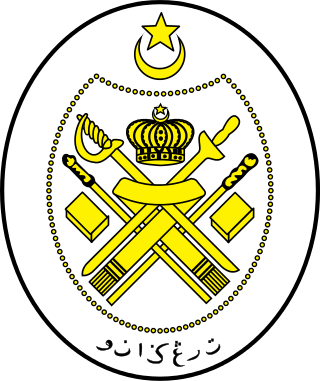
"(God) Save The Sultan" is the official state anthem of Terengganu, Malaysia. It was composed by Mohamad Hashim bin Abu Bakar in 1927, an Assistant Teacher at the Malay Primary School at Paya Bunga. He also wrote the lyrics.
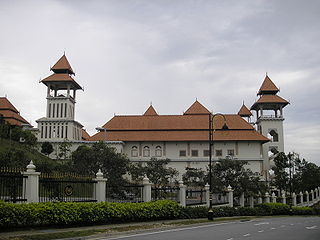
Istana Melawati is the second national palace of Malaysia's Yang di-Pertuan Agong in Putrajaya after the Istana Negara in Kuala Lumpur. It serves as a royal retreat for the Yang di-Pertuan Agong.
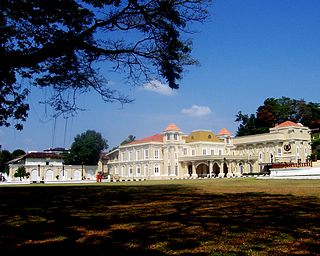
Istana Maziah is the official palace of the Sultan of Terengganu. It is located at the foot of Bukit Puteri in Kuala Terengganu, Terengganu, Malaysia. The palace is the official venue for important functions such as royal birthdays, weddings, conferment of titles and receptions for local and foreign dignitaries.

Architecture in Malaysia traditionally consist of malay vernacular architecture. Though modern contemporary architecture is prevalent in urban areas there are style influences from Islamic, colonial architecture, chinese straits etc. New materials, such as glasses and nails, were brought in by Europeans, changing the architecture.

The Malay Gamelan is a style of music originated from Indonesia, performed in ethnic Malay-populated regions of Indonesia and Malaysia as well.

The Istana Negara is the official residence of the Yang di-Pertuan Agong, the monarch of Malaysia. It is located along Jalan Tuanku Abdul Halim near Taman Duta, northwestern Kuala Lumpur. The palace opened in 2011 and replaced the old Istana Negara which was located at a different compound in central Kuala Lumpur.

The Istana Kenangan which today houses the Perak Royal Museum, was a royal residence in Kuala Kangsar in Perak, Malaysia.
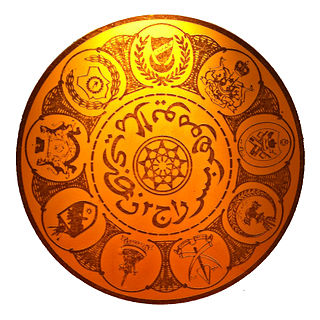
The monarchies of Malaysia exist in each of the nine Malay states under the constitutional monarchy system as practised in Malaysia. The political system of Malaysia is based on the Westminster parliamentary system in combination with features of a federation.
Tourism in Terengganu deals with attractions, events and facilities in Terengganu, Malaysia of special interest to tourists.
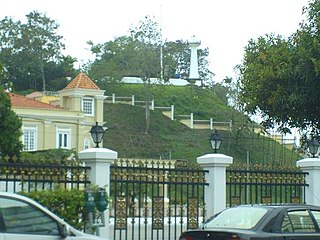
Bukit Puteri is a small hill of historical significance in Kuala Terengganu, Terengganu, Malaysia. It is located right in the middle of the city near the estuary of Terengganu River.

Traditional Malaysian art is primarily composed of Malay art and Bornean art, is very similar with the other styles from Southeast Asia, such as Bruneian, Indonesian and Singaporean. Art has a long tradition in Malaysia, with Malay art that dating back to the Malay sultanates, has always been influenced by Chinese, Indian and Islamic arts, and also present, due to large population of Chinese and Indian in today's Malaysian demographics.

Syarqiyyah palace is the palace in Malaysia located in Bukit Chendering, Kuala Terengganu, Terengganu. This palace is the main palace of the Sultan of Terengganu and all official ceremonies will take place at the palace. Inside the palace area is also the main residence for the sultan and the royal families of Terengganu. The name of Syarqiyyah is from Arabic means 'East Gem'. It is known that the palace cost an estimated RM1 Billion for construction.
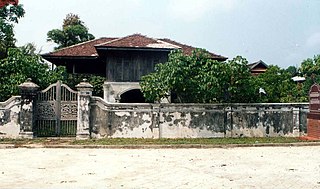
Duyong Old Fort is a historical traditional house located in Duyong Island, which is about 7 km (4.3 mi) from downtown Kuala Terengganu, Terengganu, Malaysia. The Kota Lama Duyong house is described as a “fort” or Kota in Malay simply because it was surrounded by sturdy high brick walls.